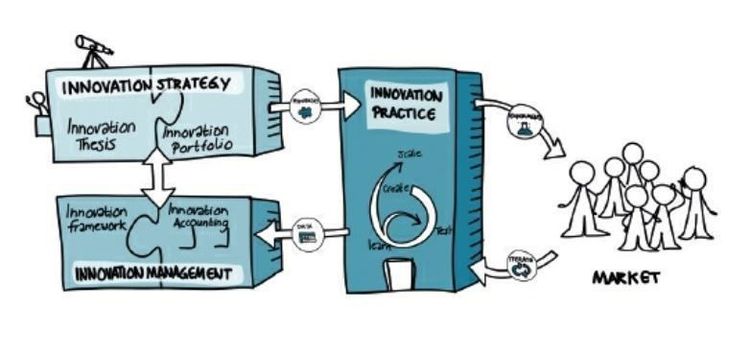Creating a Framework for Innovation
Build a sustainable innovation framework with Kantega SSO. Learn how to enable breakthroughs, from idea generation to execution, and continuous improvement

Jan 26, 2023
Innovation requires experimentation. Experimentation requires autonomy. However, we often see that teams that are given autonomy to experiment with solutions, are hindered by demands for planning and measurement from the management. We are now exploring alternative ways of leading and measuring to create a good framework for innovation.
In collaboration with our parent company Kantega, we at Kantega SSO (KSSO) have set up a learning project to explore how we can benefit from implementing an ‘innovation system’, a management framework that supports the continuous exploration of new business models. The premise is that this exploration cannot be led and measured in the same way as the core business, i.e., the things that the company presently do to create revenue.
Innovation system and accounting
An innovation system is based on the interconnection between innovation strategy, innovation practice and innovation management. The innovation strategy says what we should do (the innovation thesis) and what we should not do (the anti-thesis). It also includes an innovation portfolio, that is, an overview of the ideas that we are pursuing and where each idea is in the life cycle. The innovation practice says how we explore, test, and validate different business ideas, and innovation management defines how we can take informed decisions about our innovation activities, i.e., optimizing the effort we spend regarding the value that we can expect to get.
These concepts are explained in detail in the books "Innovation Accounting" (Toma, D. and Gons, E.), and "The Corporate Startup" (Viki, T., Toma, D. and Gons, E.).
Once these artefacts and practices are in place, an innovation account can be used. This makes it possible to measure the effect of the innovation activities. In practice, innovation accounting is all about making decisions about investing in various products, iterate on the individual innovation processes, and measuring the value of the innovation investments for the business as a whole. An important aspect is to conduct and measure different activities in different ways, depending on the maturity of the products, i.e., where they are in their life cycle.

The connection between innovation strategy, innovation management and innovation practice. Each of the elements is measured in different ways. Innovation accounting belongs under innovation management. Illustration: “VIKI, TENDAYI; TOMA, DAN; GONS, ESTHER. THE CORPORATE STARTUP (P. 45). MANAGEMENT IMPACT PUBLISHING. KINDLE EDITION”.
Learning arena: Kantega Single Sign-On
Since KSSO is in the middle of a transition period, we take the opportunity to test out methodology, tools, and principles for a stepwise introduction of innovation accounting in a smooth manner.
The project also provides relevant and practical learning in this area for several people in Kantega, because:
- Several of the leaders in Kantega are members of the KSSO board.
- Most people who work in KSSO are hired from Kantega.
How do we do that?
The book "The Corporate Startup" gives some simple advice on how to get started:
- Anchor the need for innovation accounts.
- Develop a definition of innovation that is tailored to your business.
- Create a lifecycle framework for your company's products.
- Check whether existing ways of measuring innovation fit how the business defines innovation and the product lifecycle.
- Develop new ways of measuring innovation that apply to the entire ecosystem.
- Test the system, get everyone who must contribute.
- Evaluate and update the system.
- Expand the system.
In the learning project, we will look to this advice as we try our hand. Not as a checklist, but as a guideline.
Building experience require testing out various parts of the innovation system, make adjustments that fit our organization and accept that we are not going to hit 100% on everything we do. The authors of the aforementioned books also highlight that experimentation is necessary. Learning and adjustment along the way thus becomes an important part of the learning project.
Pragmatism and autonomy
When we started this learning project we agreed on some principles, to make ensure value for the whole team. When introducing the innovation system, we emphasize that:
- It must provide value for everyone who works in KSSO, not just the board and management
- It should not increase the burden on those who work in KSSO
- It should increase the autonomy to those who work in KSSO
The last point is important because development teams are limited to creating solutions from a pre-defined specification, even when the expectation is that the solution must be innovative. When we know that innovation requires room to experiment with different methods and solutions, a lack of autonomy means that many teams cannot work innovatively.
Our hypothesis is therefore that innovation systems and accounting will contribute to more autonomy for those who develop the solutions, while managers can make better and faster decisions – at the right level.
Is there a need for an innovation system?
When you have a successful manufacturing company like KSSO, it's sometimes tempting to just manage the product and let the revenue flow in. As consultants, however, we know that the world is rapidly changing and that only those who are able to adapt to the changes and can innovate will survive in the long run. However, it is not a given that a small manufacturing company needs a complete innovation system, with all the artifacts that this entails.
The first thing we will do in the learning project is therefore to anchor the need for an innovation account. Innovation accounting is not a magical solution that fits everything. It must be adapted to the conditions and needs where it will be used. And, as mentioned earlier, it must be adapted as part of an innovation system.
In the next article we will describe how we are working to establishing the need for an innovation system.
